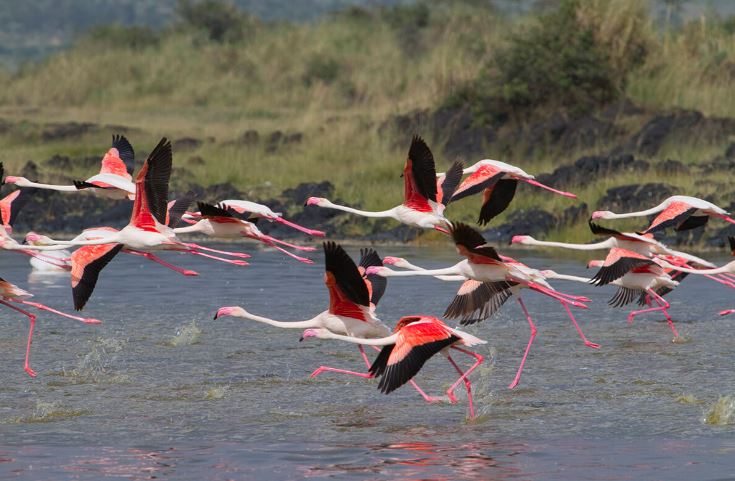


 3:30:27
3:30:27  2023-08-29
2023-08-29  993
993

Think pink—and orange? With their pink and crimson plumage, long legs and necks, and strongly hooked bills, flamingos cannot be mistaken for any other type of bird. These beauties have long fascinated people. An accurate cave painting of a flamingo, found in the south of Spain, dates back to 5,000 B.C. Today, images of flamingos are found in literature (Alice used them as croquet mallets in Through the Looking Glass by Lewis Carroll), and immortalized as plastic lawn ornaments!
The flamingo’s pink or reddish color comes from the rich sources of carotenoid pigments (like the pigments of carrots) in the algae and small crustaceans the birds eat. We eat carotenoids, too, whenever we munch on carrots, beets, and certain other veggies, but not enough to turn us orange! American flamingos, a subspecies of greater flamingo, are the brightest, showing their true colors of red, pink, or orange on their legs, bills, and faces.
In order to fly, flamingos need to run a few paces to gather speed. This speed is not related to the ground but rather to the air, so they usually take off facing into the wind. In flight, flamingos are quite distinctive, with their long necks stretched out in front and the equally long legs trailing behind. Their outstretched wings showcase the pretty black and red (or pink) coloration that, with slight variations, is shared by all flamingo species. When flying, flamingos flap their wings fairly rapidly and almost continuously. And, as with most other flamingo activities, they usually fly together in large flocks. The flamingos follow each other closely, using a variety of formations that help them take advantage of the wind currents.
Flamingos are social birds that live in groups of varying sizes, from a few pairs to sometimes thousands or tens of thousands. Their numbers add to the impressiveness of ritualized flamingo displays; the purpose of these displays is to stimulate hormone production and ensure that as many birds as possible will breed.
Why do flamingos stand on one leg? Scientists aren’t sure. There is less heat lost through the leg if it is tucked next to the bird’s body; however, this behavior is also seen in hot climates. Another explanation is more mundane: it’s probably a comfortable position for standing. You can develop your own theory about this age-old question on your next visit to the Zoo or Safari Park, where the flamingos are always gorgeous and entertaining.
Flamingos live in lagoons or large, shallow lakes. These bodies of water may be quite salty or caustic, too much so for most other animals. In some lakes, their only animal “neighbors” are algae, diatoms, and small crustaceans. That works in the flamingo’s favor, as the birds dine on these small creatures!
Chilean, Andean, and puna flamingos are found in South America; greater and lesser flamingos live in Africa, with greaters also found in the Middle East; the American or Caribbean flamingo is native to Mexico, the Caribbean, and the northernmost tip of South America.
Long legs let flamingos wade into deeper water than most other birds to look for food. And speaking of food, flamingos also have very distinctive eating habits. The bill is held upside down in the water. Flamingos feed by sucking water and mud in at the front of the bill and then pumping it out again at the sides. Here, briny plates called lamellae act like tiny filters, trapping shrimp and other small water creatures for the flamingo to eat.
The smaller puna, Andean, and lesser flamingos have deeper bills and stiff lamellae. This helps them filter very fine particles, such as algae, through their bill and keep bigger particles out. Greater and Chilean flamingos are larger and feed mostly on invertebrates such as brine flies, shrimps, and mollusks. They get these food items from the bottom mud by wading in shallow water. Sometimes they swim to get their food and sometimes by “upending” (tail feathers in the air, head underwater) like ducks.
At the San Diego Zoo and the San Diego Zoo Safari Park, the flamingos are fed a special pellet diet that is made for zoo flamingos. This food has all the nutrients the flamingos need and a pigment that helps keep them “in the pink.” To allow the flamingos to eat in their normal way (taking in water and then pumping it back out), a water source just for feeding is near their food so they can get a “beakful” of water and then food—just like they would in the wild.
Reality Of Islam |
|

"It is

The process

Astronomers

Cosmologist
 9:3:43
9:3:43
 2018-11-05
2018-11-05
10 benefits of Marriage in Islam
 7:5:22
7:5:22
 2019-04-08
2019-04-08
benefits of reciting surat yunus, hud &
 9:45:7
9:45:7
 2018-12-24
2018-12-24
advantages & disadvantages of divorce
 11:35:12
11:35:12
 2018-06-10
2018-06-10
 6:0:51
6:0:51
 2018-10-16
2018-10-16
 10:47:11
10:47:11
 2022-11-22
2022-11-22
 8:3:0
8:3:0
 2018-06-21
2018-06-21
 7:0:55
7:0:55
 2022-05-17
2022-05-17
 6:14:3
6:14:3
 2023-01-18
2023-01-18
a hero waters thirsty wild animals
 9:4:9
9:4:9
 2022-01-06
2022-01-06
 9:30:2
9:30:2
 2021-11-12
2021-11-12
 1:16:44
1:16:44
 2018-05-14
2018-05-14
 5:41:46
5:41:46
 2023-03-18
2023-03-18
| LATEST |